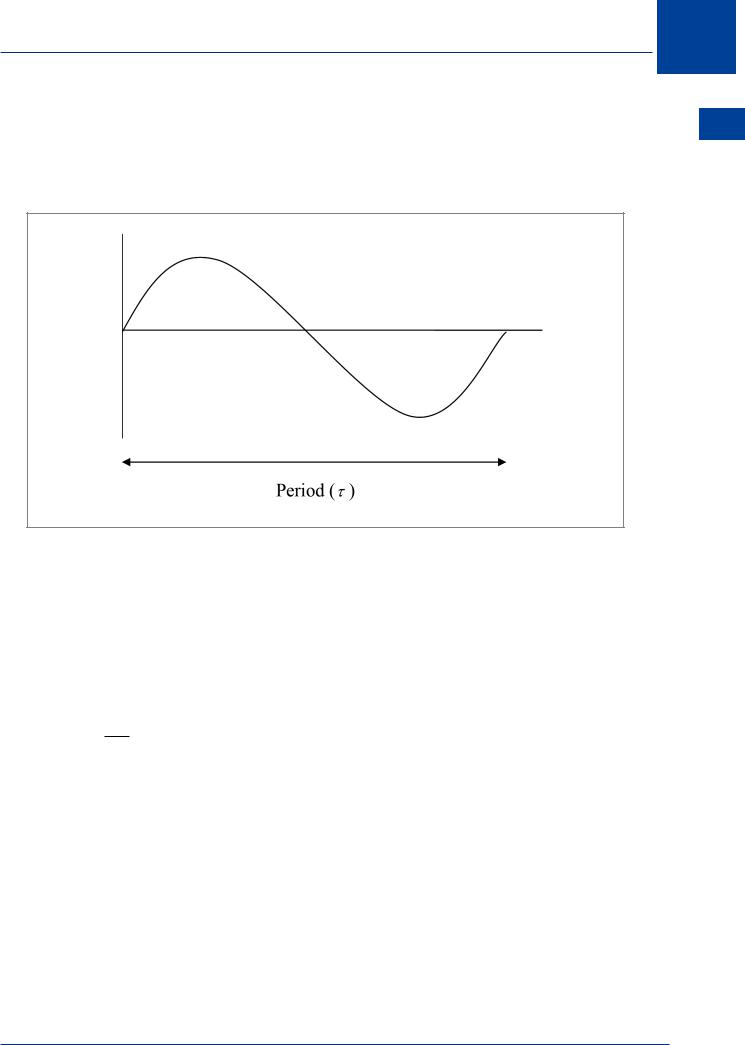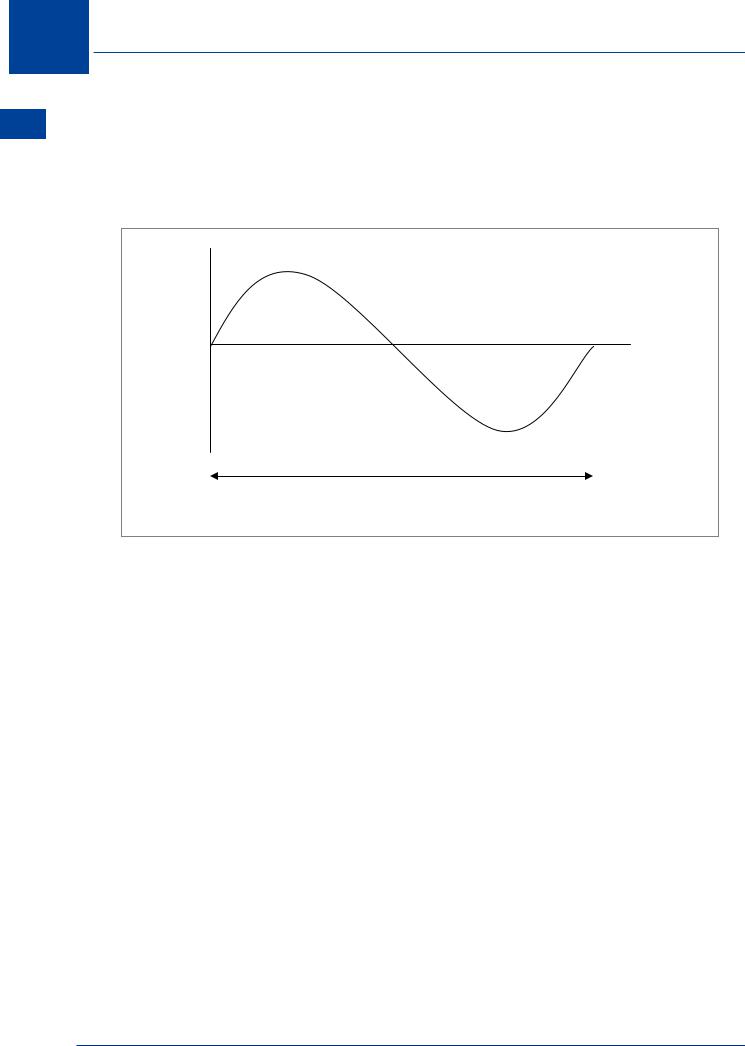
- •Textbook Series
- •Contents
- •1 Properties of Radio Waves
- •Introduction
- •The Radio Navigation Syllabus
- •Electromagnetic (EM) Radiation
- •Polarization
- •Radio Waves
- •Wavelength
- •Frequency Bands
- •Phase Comparison
- •Practice Frequency (
- •Answers to Practice Frequency (
- •Questions
- •Answers
- •2 Radio Propagation Theory
- •Introduction
- •Factors Affecting Propagation
- •Propagation Paths
- •Non-ionospheric Propagation
- •Ionospheric Propagation
- •Sky Wave
- •HF Communications
- •Propagation Summary
- •Super-refraction
- •Sub-refraction
- •Questions
- •Answers
- •3 Modulation
- •Introduction
- •Keyed Modulation
- •Amplitude Modulation (AM)
- •Single Sideband (SSB)
- •Frequency Modulation (FM)
- •Phase Modulation
- •Pulse Modulation
- •Emission Designators
- •Questions
- •Answers
- •4 Antennae
- •Introduction
- •Basic Principles
- •Aerial Feeders
- •Polar Diagrams
- •Directivity
- •Radar Aerials
- •Modern Radar Antennae
- •Questions
- •Answers
- •5 Doppler Radar Systems
- •Introduction
- •The Doppler Principle
- •Airborne Doppler
- •Janus Array System
- •Doppler Operation
- •Doppler Navigation Systems
- •Questions
- •Answers
- •6 VHF Direction Finder (VDF)
- •Introduction
- •Procedures
- •Principle of Operation
- •Range of VDF
- •Factors Affecting Accuracy
- •Determination of Position
- •VDF Summary
- •Questions
- •Answers
- •7 Automatic Direction Finder (ADF)
- •Introduction
- •Non-directional Beacon (NDB)
- •Principle of Operation
- •Frequencies and Types of NDB
- •Aircraft Equipment
- •Emission Characteristics and Beat Frequency Oscillator (BFO)
- •Presentation of Information
- •Uses of the Non-directional Beacon
- •Plotting ADF Bearings
- •Track Maintenance Using the RBI
- •Homing
- •Tracking Inbound
- •Tracking Outbound
- •Drift Assessment and Regaining Inbound Track
- •Drift Assessment and Outbound Track Maintenance
- •Holding
- •Runway Instrument Approach Procedures
- •Factors Affecting ADF Accuracy
- •Factors Affecting ADF Range
- •Accuracy
- •ADF Summary
- •Questions
- •Answers
- •8 VHF Omni-directional Range (VOR)
- •Introduction
- •The Principle of Operation
- •Terminology
- •Transmission Details
- •Identification
- •Monitoring
- •Types of VOR
- •The Factors Affecting Operational Range of VOR
- •Factors Affecting VOR Beacon Accuracy
- •The Cone of Ambiguity
- •Doppler VOR (DVOR)
- •VOR Airborne Equipment
- •VOR Deviation Indicator
- •Radio Magnetic Indicator (RMI)
- •Questions
- •In-flight Procedures
- •VOR Summary
- •Questions
- •Annex A
- •Annex B
- •Annex C
- •Answers
- •Answers to Page 128
- •9 Instrument Landing System (ILS)
- •Introduction
- •ILS Components
- •ILS Frequencies
- •DME Paired with ILS Channels
- •ILS Identification
- •Marker Beacons
- •Ground Monitoring of ILS Transmissions
- •ILS Coverage
- •ILS Principle of Operation
- •ILS Presentation and Interpretation
- •ILS Categories (ICAO)
- •Errors and Accuracy
- •Factors Affecting Range and Accuracy
- •ILS Approach Chart
- •ILS Calculations
- •ILS Summary
- •Questions
- •Answers
- •10 Microwave Landing System (MLS)
- •Introduction
- •ILS Disadvantages
- •The MLS System
- •Principle of Operation
- •Airborne Equipment
- •Question
- •Answer
- •11 Radar Principles
- •Introduction
- •Types of Pulsed Radars
- •Radar Applications
- •Radar Frequencies
- •Pulse Technique
- •Theoretical Maximum Range
- •Primary Radars
- •The Range of Primary Radar
- •Radar Measurements
- •Radar Resolution
- •Moving Target Indication (MTI)
- •Radar Antennae
- •Questions
- •Answers
- •12 Ground Radar
- •Introduction
- •Area Surveillance Radars (ASR)
- •Terminal Surveillance Area Radars
- •Aerodrome Surveillance Approach Radars
- •Airport Surface Movement Radar (ASMR)
- •Questions
- •Answers
- •13 Airborne Weather Radar
- •Introduction
- •Component Parts
- •AWR Functions
- •Principle of Operation
- •Weather Depiction
- •Control Unit
- •Function Switch
- •Mapping Operation
- •Pre-flight Checks
- •Weather Operation
- •Colour AWR Controls
- •AWR Summary
- •Questions
- •Answers
- •14 Secondary Surveillance Radar (SSR)
- •Introduction
- •Advantages of SSR
- •SSR Display
- •SSR Frequencies and Transmissions
- •Modes
- •Mode C
- •SSR Operating Procedure
- •Special Codes
- •Disadvantages of SSR
- •Mode S
- •Pulses
- •Benefits of Mode S
- •Communication Protocols
- •Levels of Mode S Transponders
- •Downlink Aircraft Parameters (DAPS)
- •Future Expansion of Mode S Surveillance Services
- •SSR Summary
- •Questions
- •Answers
- •15 Distance Measuring Equipment (DME)
- •Introduction
- •Frequencies
- •Uses of DME
- •Principle of Operation
- •Twin Pulses
- •Range Search
- •Beacon Saturation
- •Station Identification
- •VOR/DME Frequency Pairing
- •DME Range Measurement for ILS
- •Range and Coverage
- •Accuracy
- •DME Summary
- •Questions
- •Answers
- •16 Area Navigation Systems (RNAV)
- •Introduction
- •Benefits of RNAV
- •Types and Levels of RNAV
- •A Simple 2D RNAV System
- •Operation of a Simple 2D RNAV System
- •Principle of Operation of a Simple 2D RNAV System
- •Limitations and Accuracy of Simple RNAV Systems
- •Level 4 RNAV Systems
- •Requirements for a 4D RNAV System
- •Control and Display Unit (CDU)
- •Climb
- •Cruise
- •Descent
- •Kalman Filtering
- •Questions
- •Appendix A
- •Answers
- •17 Electronic Flight Information System (EFIS)
- •Introduction
- •EHSI Controller
- •Full Rose VOR Mode
- •Expanded ILS Mode
- •Full Rose ILS Mode
- •Map Mode
- •Plan Mode
- •EHSI Colour Coding
- •EHSI Symbology
- •Questions
- •Appendix A
- •Answers
- •18 Global Navigation Satellite System (GNSS)
- •Introduction
- •Satellite Orbits
- •Position Reference System
- •The GPS Segments
- •The Space Segment
- •The Control Segment
- •The User Segment
- •Principle Of Operation
- •GPS Errors
- •System Accuracy
- •Integrity Monitoring
- •Differential GPS (DGPS)
- •Combined GPS and GLONASS Systems
- •Questions
- •Answers
- •19 Revision Questions
- •Questions
- •Answers
- •Specimen Examination Paper
- •Appendix A
- •Answers to Specimen Examination Paper
- •Explanation of Selected Questions
- •20 Index

Properties of RadioWaves 1
Radio Waves
The length of time it takes to generate one cycle of a radio wave is known as the period and is generally signified by the Greek letter tau (τ), and measured in microseconds (µs). (1 µs = 10-6 second).
Properties of Radio Waves 1
Figure 1.2 Sinusoidal wave - period
If, for example, the period of one cycle of a radio wave is 0.125 µs then the number of cycles produced in one second would be the reciprocal of this giving:
1 |
= |
1 |
= 8 000 000 cycles per second which are known as hertz (Hz) |
τ |
0.125 ×10-6 |
This is known as the frequency (f) of the wave; hence:
f = |
1 |
(1) |
τ |
The frequency of radio waves is expressed in hertz (Hz). Since the order of magnitude of the frequency of radio waves is very high, for convenience, the following terms are used to express the frequency:
Kilohertz (kHz) |
= |
103 |
Hz = |
1 000 Hz |
Megahertz (MHz) |
= |
106 |
Hz = |
1 000 000 Hz |
Gigahertz (GHz) |
= |
109 |
Hz = |
1 000 000 000 Hz |
So in the example above the frequency would be expressed as 8 MHz.
5

1 Properties of RadioWaves
Waves Radio of Properties 1
Wavelength
The speed of radio waves (c) is the same as the speed of light (which is also EM radiation) and is approximately:
300 000 000 ms-1 (= 300 × 106 ms-1), or 162 000 nautical miles per second
Wavelength ( λ )
Figure 1.3 Sinusoidal wave - wavelength
If a radio wave travels at 300 × 106 ms-1 and the period is 0.125 µs, then the length (λ) of each wave will be:
λ = c. τ |
(2) |
300 × 106 × 0.125 × 10-6 = 37.5 m |
|
This is known as the wavelength. From equation (1) this can also be stated as:
λ = |
c |
(3) |
|
f |
|||
|
|
Giving:
λ = |
300 × 106 |
= 37.5 m |
|
8 × 106 |
|||
|
|
Hence if the frequency is known then the wavelength can be determined and if the wavelength is known then the frequency can be calculated from:
f = |
c |
(4) |
|
λ |
|||
|
6

Properties of RadioWaves 1
Examples:
1.If the frequency of a radio wave is 121.5 MHz calculate the wavelength.
λ = |
c |
= |
300 × 106 |
= 2.47 m |
|
f |
121.5 × 106 |
||||
|
|
|
2. If the wavelength is 1515 m, what is the corresponding frequency?
f = |
c |
= |
300 × 106 |
= 198 000 Hz = 198 × 103 |
Hz = 198 kHz |
|
λ |
1515 |
|||||
|
|
|
|
For ease of calculation we can simplify the formulae:
f |
= |
300 |
MHz |
||
|
|
||||
|
λ (m) |
||||
λ |
= |
300 |
|
m |
|
|
|
||||
|
f (MHz) |
||||
But we must ensure that our input arguments are correct, i.e. to calculate the frequency the wavelength must be in metres and to calculate the wavelength the frequency must be input in MHz.
Examples:
3.Determine the frequency corresponding to a wavelength of 3.2 cm.
Noting that 3.2 cm = 0.032 m the calculation becomes:
f = |
300 |
= |
9375 MHz (or 9.375 GHz) |
|
|
||||
0.032 |
||||
|
|
|
Properties of Radio Waves 1
4.Determine the wavelength corresponding to a frequency of 357 kHz. Noting that 375 kHz = 0.375 MHz the calculation is:
λ = |
300 |
= |
800 m |
|
|
||||
0.375 |
||||
|
|
|
7

1 Properties of RadioWaves
Waves Radio of Properties 1
Frequency Bands
The radio part of the electromagnetic spectrum extends from 3 kHz to 300 GHz. For convenience it is divided into 8 frequency bands. These are shown below with the frequencies, wavelengths and the uses made of the frequency bands in civil aviation. Note that each frequency band is related to its neighbouring band(s) by a factor of 10.
Frequency Band |
Frequencies |
Wavelengths |
Civil Aeronautical Usage |
|
|
|
|
|
|
Very Low Frequency (VLF) |
3 – 30 kHz |
100 – 10 km |
Nil |
|
|
|
|
|
|
Low Frequency (LF) |
30 – 300 kHz |
10 – 1 km |
NDB/ADF |
|
|
|
|
|
|
Medium Frequency (MF) |
300 – 3000 kHz |
1000 – 100 m |
NDB/ADF, long range |
|
communications |
||||
|
|
|
||
|
|
|
|
|
High Frequency (HF) |
3 – 30 MHz |
100 – 10 m |
long range |
|
communications |
||||
|
|
|
||
|
|
|
|
|
|
|
|
Short range |
|
Very High Frequency |
30 – 300 MHz |
10 – 1 m |
communication, VDF, |
|
(VHF) |
VOR, ILS localizer, marker |
|||
|
|
|||
|
|
|
beacons |
|
|
|
|
|
|
Ultra High Frequency |
|
|
ILS glide path, DME, SSR, |
|
300 – 3000 MHz |
100 – 10 cm |
Satellite communications, |
||
(UHF) |
||||
|
|
GNSS, long range radars |
||
|
|
|
||
|
|
|
|
|
Super High Frequency |
3 – 30 GHz |
10 – 1 cm |
RADALT, AWR, MLS, short |
|
(SHF) |
range radars |
|||
|
|
|||
|
|
|
|
|
Extremely High |
30 – 300 GHz |
10 – 1 mm |
Nil |
|
Frequency (EHF) |
||||
|
|
|
||
|
|
|
|
8
